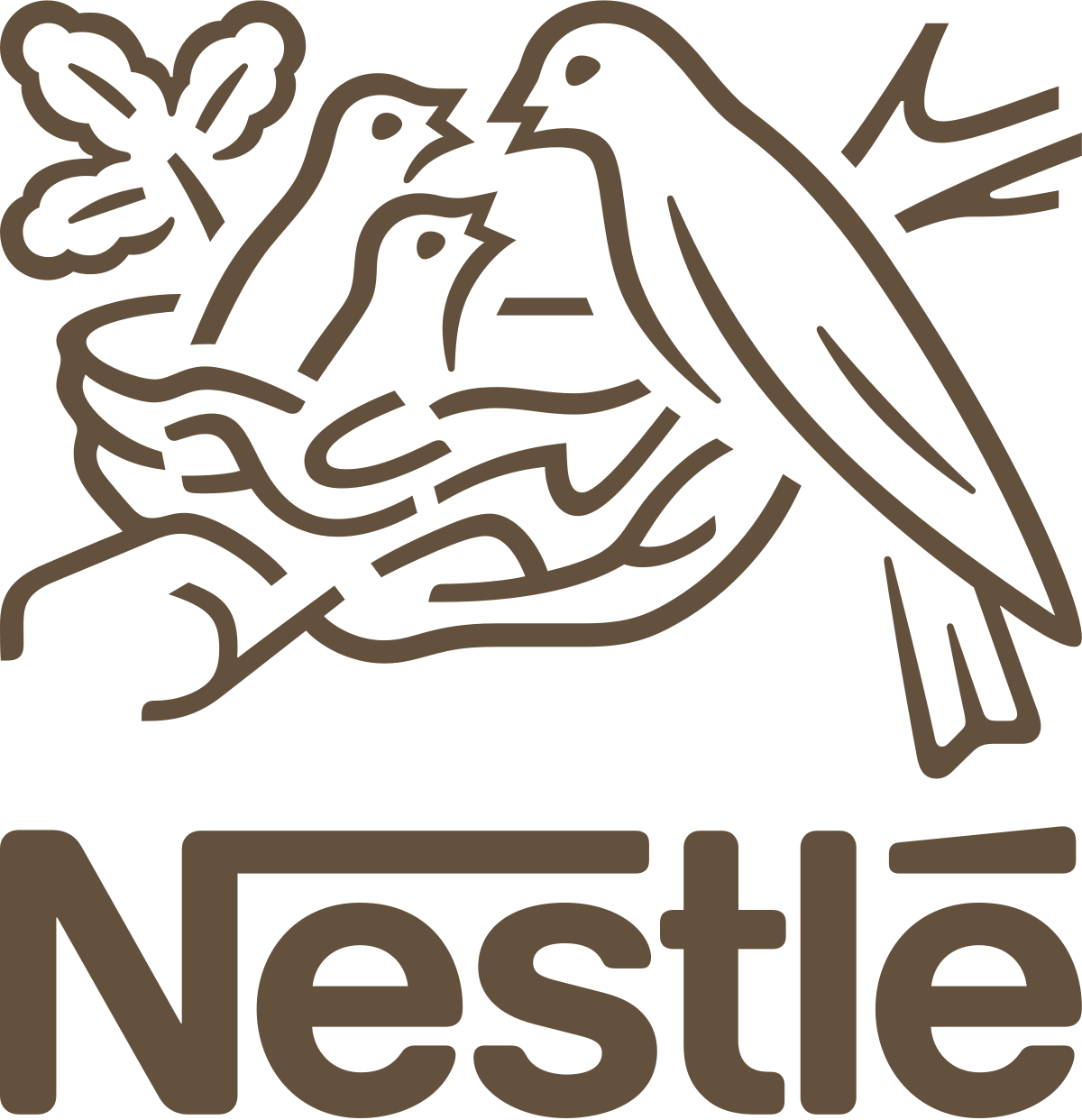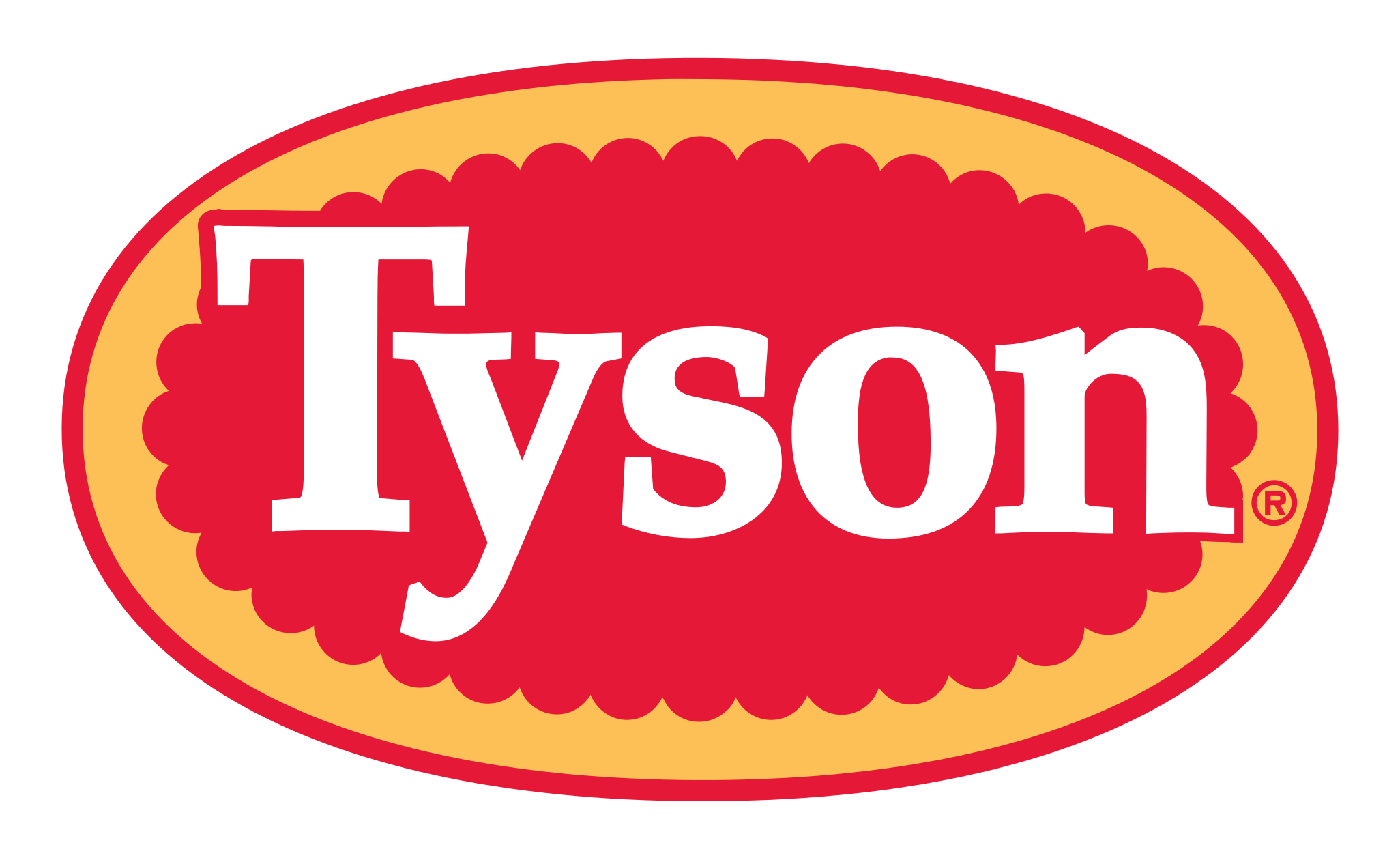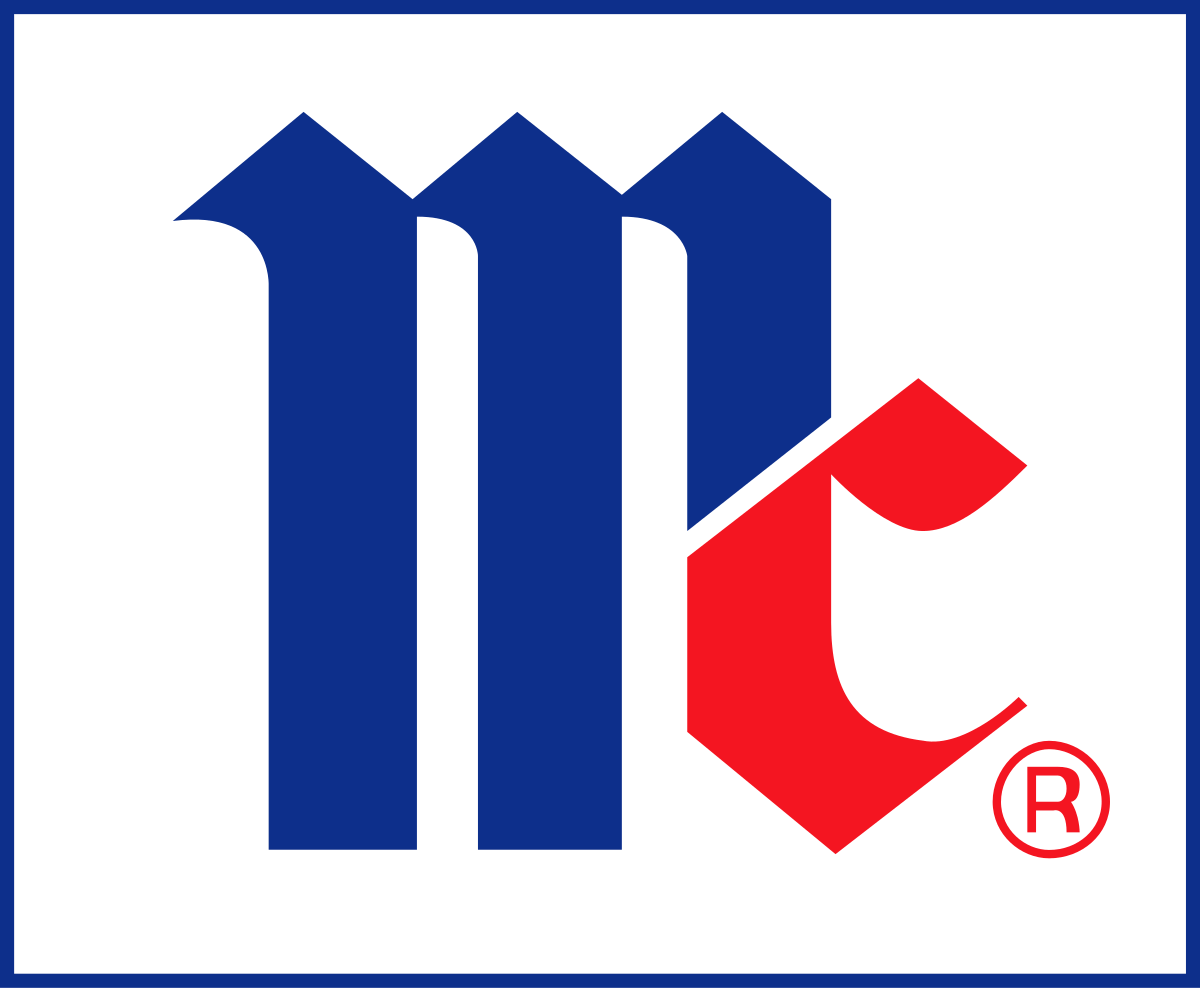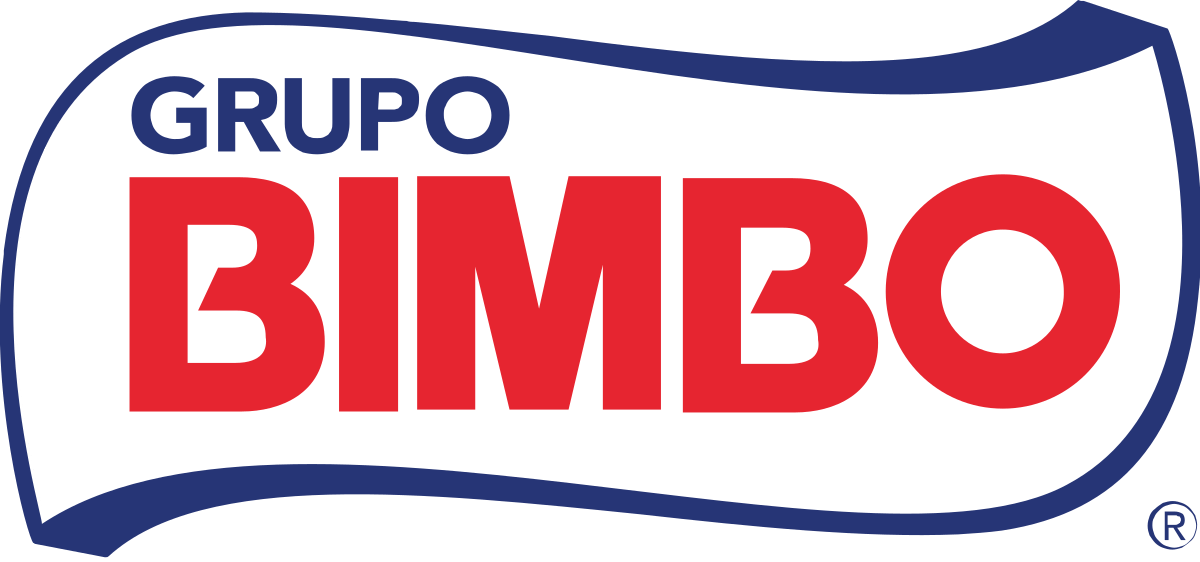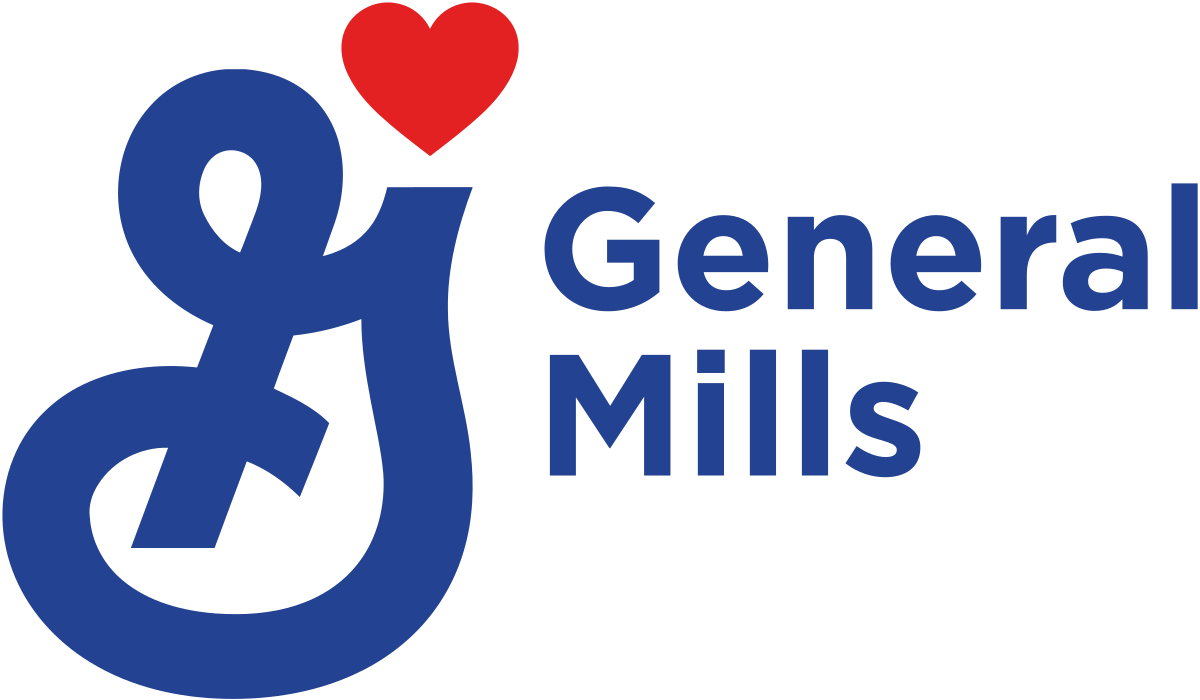Global Adaptogens Market, By Source, by Form, By Application, By Distribution Channel, By Region & Segmental Insights Trends and Forecast, 2024 – 2034
- Industry: Food & Beverages
- Report ID: TNR-110-1287
- Number of Pages: 420
- Table/Charts : Yes
- September, 2024
- Base Year : 2024
- No. of Companies : 10+
- No. of Countries : 29
- Views : 10090
- Covid Impact Covered: Yes
- War Impact Covered: Yes
- Formats : PDF, Excel, PPT
Adaptogens are natural substances, often derived from plants and fungi, that help the body adapt to stress and maintain balance. They are widely used to enhance resilience against physical, mental, and environmental stressors. Common adaptogens include ashwagandha, ginseng, and Rhodiola Rosea, which are known for boosting energy, improving mental clarity, and supporting the immune system.
People use adaptogens to manage stress, reduce fatigue, and promote overall well-being. They are found in dietary supplements, functional foods, and personal care products. The adaptogens market is projected to experience significant growth in the coming years, driven by increasing consumer awareness of natural health products. The market is expected to grow at a robust CAGR, reflecting the rising demand for stress-relief solutions and holistic wellness products.
The Global Adaptogens Market Generated Revenue of US$ 10.6 Billion in 2023 and US$ 22.5 Billion in 2034 and is Expected to Grow at a CAGR of 7.3% from 2024 to 2034.
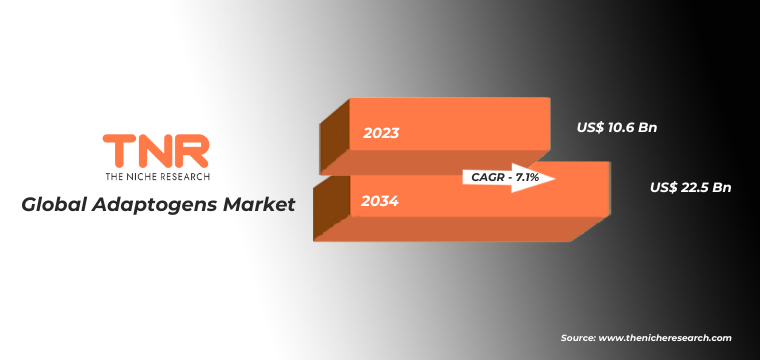
Consumption of Adaptogens Per Day:
Daily consumption of adaptogens typically ranges from 200 to 600 mg, depending on the specific adaptogen and individual needs. Consuming them regularly can help enhance stress resilience, support mental clarity, and improve overall well-being.
| PRODUCT TYPE | PER DAY |
| Ashwagandha | 1,000 mg or less per day |
| Ginseng | 200-400 mg |
| Astragalus | 60 gms |
| Holy Basils | 500 mg |
| Rhodiola Roseas | As recommended by Physician |
| Schisandra | As recommended by Physician |
| Adaptogenic Mushrooms | As recommended by Physician |
Adaptogens Market Dynamic:
Growth Drivers-
- Increasing Consumer Focus on Health and Wellness: Growing awareness of the benefits of natural remedies is driving the demand for adaptogens. Consumers are increasingly seeking products that help manage stress, boost immunity, and improve overall well-being, contributing to the market’s expansion.
- Rising Popularity of Functional Foods and Beverages: The incorporation of adaptogens into functional foods and beverages is gaining traction. As consumers prioritize holistic health, the demand for adaptogen-infused products like teas, energy bars, and supplements is rising, fueling market growth.
- Expanding Application in Personal Care Products: Adaptogens are increasingly being used in skincare and beauty products due to their potential to reduce stress-induced skin issues. The growing interest in natural and organic beauty products is driving the adaptogens market forward.
Challenges-
- Regulatory Hurdles and Lack of Standardization: The global adaptogens market faces challenges due to varying regulations and the absence of standardized guidelines. Inconsistent quality control and labeling practices across regions can hinder consumer trust and slow market growth.
- Limited Scientific Validation: While adaptogens are popular for their natural benefits, limited scientific research and clinical trials supporting their effectiveness present a challenge. The lack of robust evidence may lead to skepticism among consumers and healthcare professionals, affecting market adoption.
- High Production Costs: The cultivation and extraction of high-quality adaptogens can be expensive, driving up production costs. These higher costs are often passed on to consumers, which could limit the market’s accessibility and growth potential, especially in price-sensitive regions.
Adaptogens Market Segmentation by Source, Form, Application, Distribution Channel, Region
Ginseng segment is set to dominate the adaptogens market, commanding a substantial revenue share of 20.5% over the forecast period. Ginseng is highly preferred due to its well-documented health benefits, including enhanced energy levels, improved cognitive function, and strengthened immune response. Its adaptogenic properties help the body resist stress and maintain balance, making it a popular choice for those seeking natural remedies for fatigue and mental clarity. Additionally, ginseng has a long history of use in traditional medicine, contributing to its credibility and trust among consumers. Its versatility in formulations, from supplements to teas, further enhances its appeal over other adaptogenic sources.
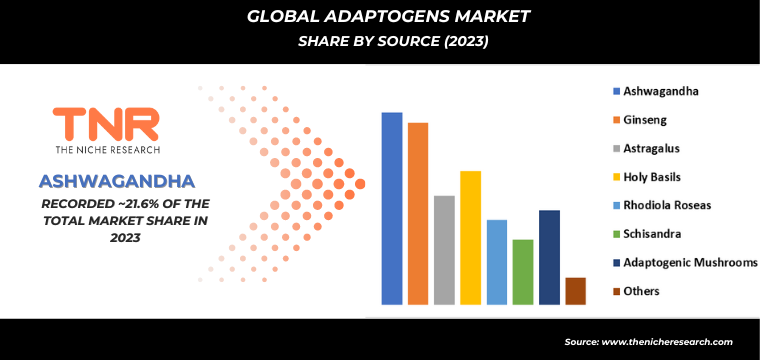
Powder form dominated the global adaptogens market, acquiring a revenue share of 33.8% due to its versatility and ease of use. Consumers prefer powder adaptogens as they can be easily mixed into beverages, smoothies, and foods, offering a convenient way to incorporate these health-boosting ingredients into daily routines. Additionally, the powder form typically offers higher potency and faster absorption compared to capsules or tablets, allowing for quicker effects. The flexibility in dosage also appeals to health-conscious individuals who customize their intake based on specific needs. Furthermore, powder adaptogens are often more cost-effective, providing consumers with a budget-friendly option to maintain their wellness goals.
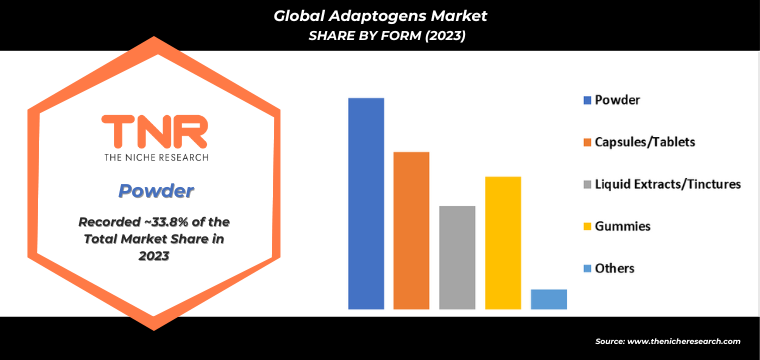
Cosmetics segment is anticipated to be the fastest-growing application in the adaptogens market, capturing a substantial revenue share of 15.5% over the forecast period. This growth is driven by the increasing consumer demand for natural and organic skincare products that offer more than just superficial benefits. Adaptogens, known for their ability to reduce stress and balance hormones, are being incorporated into cosmetics to enhance skin resilience, combat aging, and promote a healthy complexion. Ingredients like ashwagandha and ginseng are particularly popular for their antioxidant properties, which protect the skin from environmental damage. The rising awareness of the connection between skin health and overall wellness further fuels the demand for adaptogen-infused cosmetics.
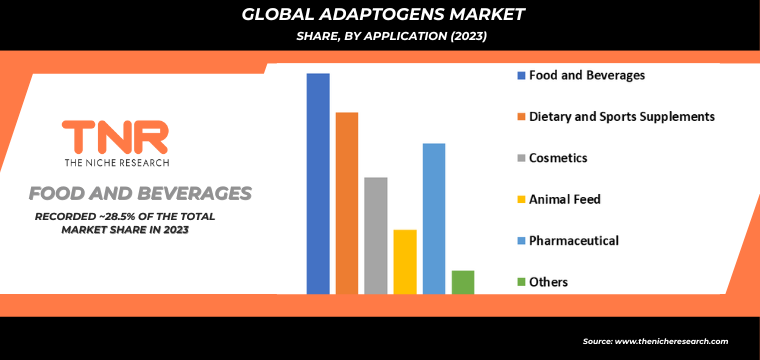
Offline channel is more preferable than online channel in the global adaptogens market. Consumers often seek personalized advice and the ability to physically inspect products before purchasing, which offline stores provide. Health and wellness products, like adaptogens, benefit from in-store consultations, where consumers can get recommendations tailored to their specific needs. Additionally, trusted relationships with local retailers and the opportunity to sample products drive the preference for offline shopping. Moreover, offline channels often have established credibility, especially in regions where consumers are less familiar with online shopping. This trust and convenience make the offline channel a dominant force in the adaptogens market capturing a CAGR of 6.4%.

In 2023, Asia Pacific is anticipated to play a significant role in propelling the growth of the adaptogens market, contributing approximately 38.4% to its overall expansion. Manufacturers in the region are increasingly focusing on innovation and product development to capitalize on this growth. They are investing in research and development to create high-quality, potent adaptogen products that cater to local consumer preferences for natural and traditional remedies. Additionally, strategic partnerships, localized marketing strategies, and expanding distribution networks are being employed to strengthen their market presence. The rich availability of adaptogenic herbs like ginseng and ashwagandha in Asia Pacific further bolsters the region’s leadership in the global market.
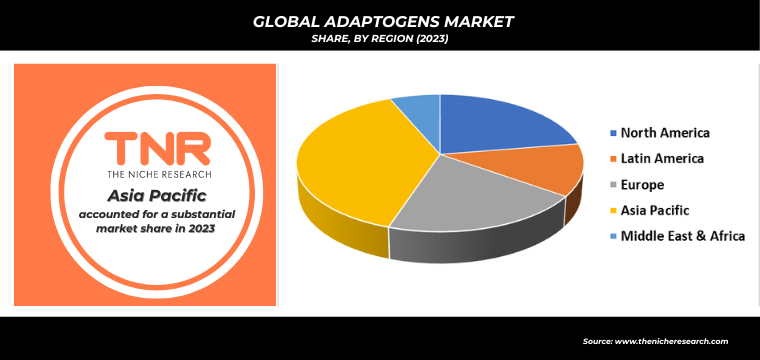
Country Wise Production of Adaptogens:

Major Players in Adaptogens Market
- Nutra Science Labs
- Nutracap Labs
- Organic Herb Inc
- Organic India
- Organika Health Products Inc
- PLT Health Solutions
- REBBL
- UNO VETCHEM
- Xi’an Greena Biotech Co. Ltd.
- Xian Yuensun Biological Technology Co. Ltd.
- Other Industry Participants
Global Adaptogens Market Scope:
| Report Specifications | Details |
| Market Revenue in 2023 | US$ 10.6 Bn |
| Market Size Forecast by 2034 | US$ 22.5 Bn |
| Growth Rate (CAGR) | 7.1% |
| Historic Data | 2016 – 2022 |
| Base Year for Estimation | 2023 |
| Forecast Period | 2024 – 2034 |
| Report Inclusions | Market Size & Estimates, Market Dynamics, Competitive Scenario, Trends, Growth Factors, Market Determinants, Key Investment Segmentation, Product/Service/Solutions Benchmarking |
| Segments Covered | By Source, By Form, By Application, By Distribution Channel, By Region |
| Regions Covered | North America, Europe, Asia Pacific, Middle East & Africa, Latin America |
| Countries Covered | U.S., Canada, Mexico, Rest of North America, France, The UK, Spain, Germany, Italy, Nordic Countries (Denmark, Finland, Iceland, Sweden, Norway), Benelux Union (Belgium, The Netherlands, Luxembourg), Rest of Europe, China, Japan, India, New Zealand, Australia, South Korea, Southeast Asia (Indonesia, Thailand, Malaysia, Singapore, Rest of Southeast Asia), Rest of Asia Pacific, Saudi Arabia, UAE, Egypt, Kuwait, South Africa, Rest of Middle East & Africa, Brazil, Argentina, Rest of Latin America |
| Key Players | Nutra Science Labs, Nutracap Labs, Organic Herb Inc, Organic India, Organika Health Products Inc,PLT Health Solutions, REBBL, UNO VETCHEM, Xi’an Greena Biotech Co. Ltd., Xian Yuensun Biological Technology Co. Ltd. |
| Customization Scope | Customization allows for the inclusion/modification of content pertaining to geographical regions, countries, and specific market segments. |
| Pricing & Procurement Options | Explore purchase options tailored to your specific research requirements |
| Contact Details | Consult With Our Expert
Japan (Toll-Free): +81 663-386-8111 South Korea (Toll-Free): +82-808- 703-126 Saudi Arabia (Toll-Free): +966 800-850-1643 United Kingdom: +44 753-710-5080 United States: +1 302-232-5106 E-mail: askanexpert@thenicheresearch.com
|
Global Adaptogens Market
By Source
- Ashwagandha
- Ginseng
- Astragalus
- Holy Basils
- Rhodiola Roseas
- Schisandra
- Adaptogenic Mushrooms
- Others
By Form
- Powder
- Capsules/Tablets
- Liquid Extracts/Tinctures
- Gummies
- Others
By Application
- Food and Beverages
- Dietary and Sports Supplements
- Cosmetics
- Animal Feed
- Pharmaceutical
- Others
By Distribution Channel
- Online
- Offline
- Health and Wellness Stores
- Specialty Stores
- Supermarket/Hypermarket
- Others
By Region
- North America (U.S., Canada, Mexico, Rest of North America)
- Europe (France, The UK, Spain, Germany, Italy, Nordic Countries (Denmark, Finland, Iceland, Sweden, Norway), Benelux Union (Belgium, The Netherlands, Luxembourg), Rest of Europe)
- Asia Pacific (China, Japan, India, New Zealand, Australia, South Korea, Southeast Asia (Indonesia, Thailand, Malaysia, Singapore, Rest of Southeast Asia), Rest of Asia Pacific)
- Middle East & Africa (Saudi Arabia, UAE, Egypt, Kuwait, South Africa, Rest of Middle East & Africa)
- Latin America (Brazil, Argentina, Rest of Latin America)
Report Layout:
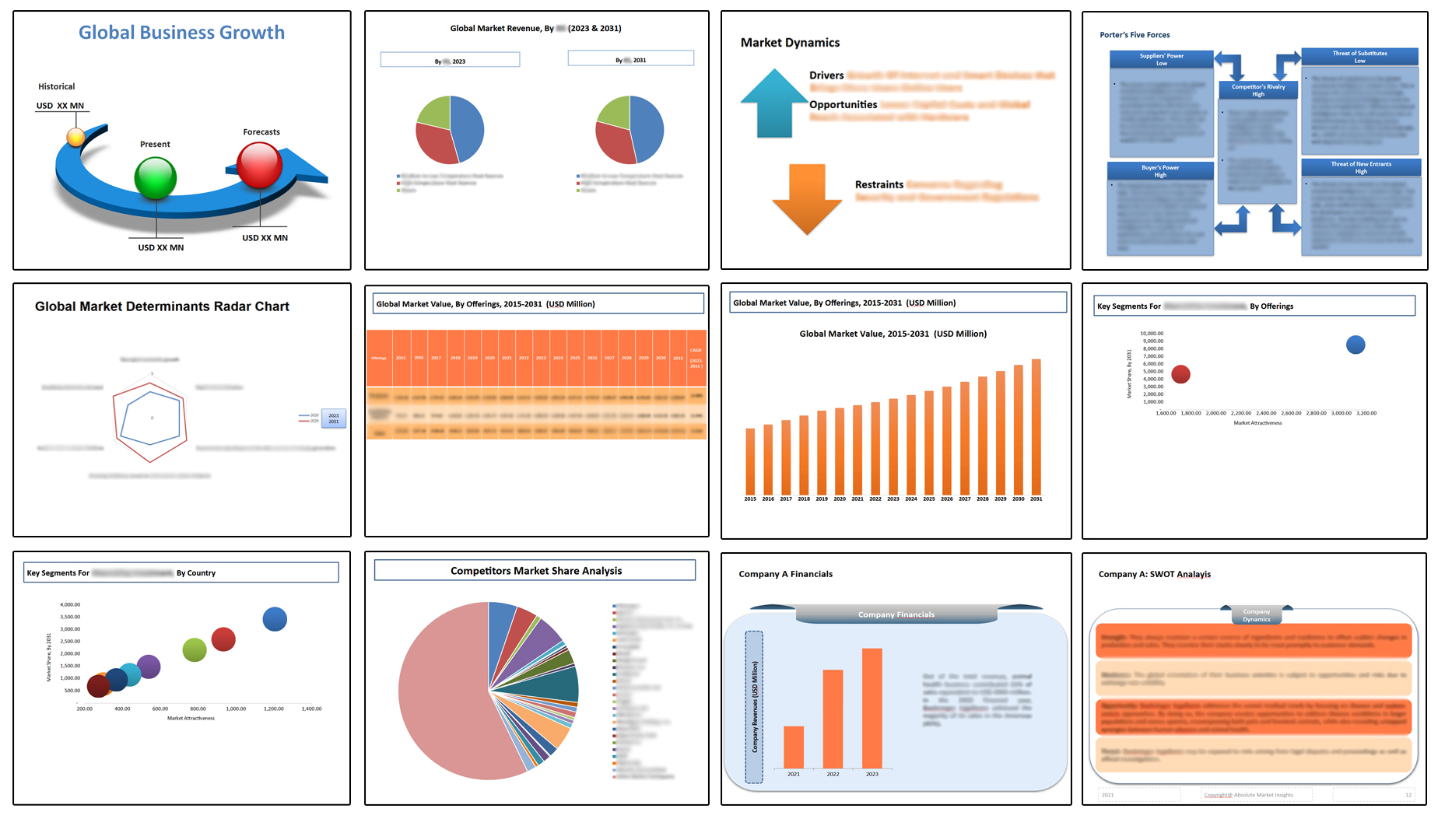
Table of Contents
Note: This ToC is tentative and can be changed according to the research study conducted during the course of report completion.
**Exclusive for Multi-User and Enterprise User.
Global Adaptogens Market
By Source
- Ashwagandha
- Ginseng
- Astragalus
- Holy Basils
- Rhodiola Roseas
- Schisandra
- Adaptogenic Mushrooms
- Others
By Form
- Powder
- Capsules/Tablets
- Liquid Extracts/Tinctures
- Gummies
- Others
By Application
- Food and Beverages
- Dietary and Sports Supplements
- Cosmetics
- Animal Feed
- Pharmaceutical
- Others
By Distribution Channel
- Online
- Offline
- Health and Wellness Stores
- Specialty Stores
- Supermarket/Hypermarket
- Others
By Region
- North America (U.S., Canada, Mexico, Rest of North America)
- Europe (France, The UK, Spain, Germany, Italy, Nordic Countries (Denmark, Finland, Iceland, Sweden, Norway), Benelux Union (Belgium, The Netherlands, Luxembourg), Rest of Europe)
- Asia Pacific (China, Japan, India, New Zealand, Australia, South Korea, Southeast Asia (Indonesia, Thailand, Malaysia, Singapore, Rest of Southeast Asia), Rest of Asia Pacific)
- Middle East & Africa (Saudi Arabia, UAE, Egypt, Kuwait, South Africa, Rest of Middle East & Africa)
- Latin America (Brazil, Argentina, Rest of Latin America)
The Niche Research approach encompasses both primary and secondary research methods to provide comprehensive insights. While primary research is the cornerstone of our studies, we also incorporate secondary research sources such as company annual reports, premium industry databases, press releases, industry journals, and white papers.
Within our primary research, we actively engage with various industry stakeholders, conducting paid interviews and surveys. Our meticulous analysis extends to every market participant in major countries, allowing us to thoroughly examine their portfolios, calculate market shares, and segment revenues.
Our data collection primarily focuses on individual countries within our research scope, enabling us to estimate regional market sizes. Typically, we employ a bottom-up approach, meticulously tracking trends in different countries. We analyze growth drivers, constraints, technological innovations, and opportunities for each country, ultimately arriving at regional figures.Our process begins by examining the growth prospects of each country. Building upon these insights, we project growth and trends for the entire region. Finally, we utilize our proprietary model to refine estimations and forecasts.
Our data validation standards are integral to ensuring the reliability and accuracy of our research findings. Here’s a breakdown of our data validation processes and the stakeholders we engage with during our primary research:
- Supply Side Analysis: We initiate a supply side analysis by directly contacting market participants, through telephonic interviews and questionnaires containing both open-ended and close-ended questions. We gather information on their portfolios, segment revenues, developments, and growth strategies.
- Demand Side Analysis: To gain insights into adoption trends and consumer preferences, we reach out to target customers and users (non-vendors). This information forms a vital part of the qualitative analysis section of our reports, covering market dynamics, adoption trends, consumer behavior, spending patterns, and other related aspects.
- Consultant Insights: We tap into the expertise of our partner consultants from around the world to obtain their unique viewpoints and perspectives. Their insights contribute to a well-rounded understanding of the markets under investigation.
- In-House Validation: To ensure data accuracy and reliability, we conduct cross-validation of data points and information through our in-house team of consultants and utilize advanced data modeling tools for thorough verification.
The forecasts we provide are based on a comprehensive assessment of various factors, including:
- Market Trends and Past Performance (Last Five Years): We accurately analyze market trends and performance data from preceding five years to identify historical patterns and understand the market’s evolution.
- Historical Performance and Growth of Market Participants: We assess the historical performance and growth trajectories of key market participants. This analysis provides insights into the competitive landscape and individual company strategies.
- Market Determinants Impact Analysis (Next Eight Years): We conduct a rigorous analysis of the factors that are projected to influence the market over the next eight years. This includes assessing both internal and external determinants that can shape market dynamics.
- Drivers and Challenges for the Forecast Period:Identify the factors expected to drive market growth during the forecast period, as well as the challenges that the industry may face. This analysis aids in deriving an accurate growth rate projection.
- New Acquisitions, Collaborations, or Partnerships: We keep a close watch on any new acquisitions, collaborations, or partnerships within the industry. These developments can have a significant impact on market dynamics and competitiveness.
- Macro and Micro Factors Analysis:A thorough examination of both macro-level factors (e.g., economic trends, regulatory changes) and micro-level factors (e.g., technological advancements, consumer preferences) that may influence the market during the forecast period.
- End-User Sentiment Analysis: To understand the market from the end-user perspective, we conduct sentiment analysis. This involves assessing the sentiment, preferences, and feedback of the end-users, which can provide valuable insights into market trends.
- Perspective of Primary Participants: Insights gathered directly from primary research participants play a crucial role in shaping our forecasts. Their perspectives and experiences provide valuable qualitative data.
- Year-on-Year Growth Trend: We utilize a year-on-year growth trend based on historical market growth and expected future trends. This helps in formulating our growth projections, aligning them with the market’s historical performance.
Research process adopted by TNR involves multiple stages, including data collection, validation, quality checks, and presentation. It’s crucial that the data and information we provide add value to your existing market understanding and expertise. We have also established partnerships with business consulting, research, and survey organizations across regions and globally to collaborate on regional analysis and data validation, ensuring the highest level of accuracy and reliability in our reports.
